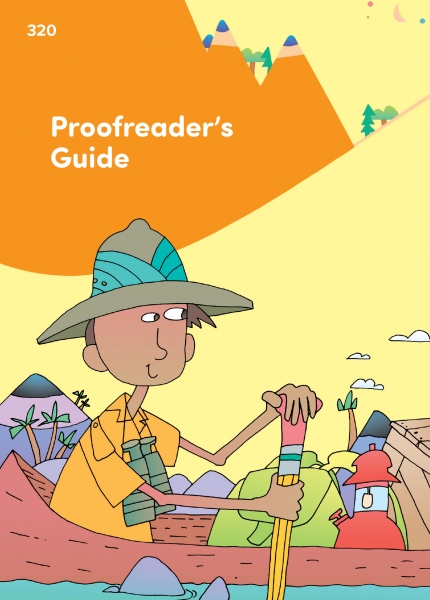Page 320 from

Start-Up Activity
The “Proofreader’s Guide” is a reference section for punctuation, mechanics, spelling, commonly misused words, sentence structure, and parts of speech. This section is designed to make the information easy to use. Have students turn to page 322. As they will see, the subject—periods—is at the top of the page. Down the left-hand margin, the rules for using periods are named. Then in the main part of the text, each rule is explained and examples are given.
With your help, students should learn to use the “Proofreader’s Guide” whenever they have a question about a certain rule. Such questions will naturally arise during the editing step of the writing process. Have students in pairs follow the directions below to search for basic types of information in the “Proofreader’s Guide.”
- Go to “Marking Punctuation,” beginning on page 321. Write the names of the first three punctuation marks listed on this page.
- Go to “Checking Mechanics,” beginning on page 332. List five common abbreviations.
- Go to “Using the Right Word,” beginning on page 344. Write a new set of sentences for hear and here.
- Go to “Understanding Our Language,” beginning on page 354. List the eight parts of speech.
Special Note: You should also help students use the index (pages 421–432) to access information about specific rules. You can do this by providing students with a series of Index-based questions like the following:
- On what page would you find information about using question marks?
For more activities like the ones included in this teacher's guide chapter, see the Write on Track SkillsBook.
Think About It
“I know that spelling, punctuation, and grammar are boring, but they are necessary.”
—Beverly Cleary

Start-Up Activity
The “Proofreader’s Guide” is a reference section for punctuation, mechanics, spelling, commonly misused words, sentence structure, and parts of speech. This section is designed to make the information easy to use. Have students turn to page 322. As they will see, the subject—periods—is at the top of the page. Down the left-hand margin, the rules for using periods are named. Then in the main part of the text, each rule is explained and examples are given.
With your help, students should learn to use the “Proofreader’s Guide” whenever they have a question about a certain rule. Such questions will naturally arise during the editing step of the writing process. Have students in pairs follow the directions below to search for basic types of information in the “Proofreader’s Guide.”
- Go to “Marking Punctuation,” beginning on page 321. Write the names of the first three punctuation marks listed on this page.
- Go to “Checking Mechanics,” beginning on page 332. List five common abbreviations.
- Go to “Using the Right Word,” beginning on page 344. Write a new set of sentences for hear and here.
- Go to “Understanding Our Language,” beginning on page 354. List the eight parts of speech.
Special Note: You should also help students use the index (pages 421–432) to access information about specific rules. You can do this by providing students with a series of Index-based questions like the following:
- On what page would you find information about using question marks?
For more activities like the ones included in this teacher's guide chapter, see the Write on Track SkillsBook.
Think About It
“I know that spelling, punctuation, and grammar are boring, but they are necessary.”
—Beverly Cleary




